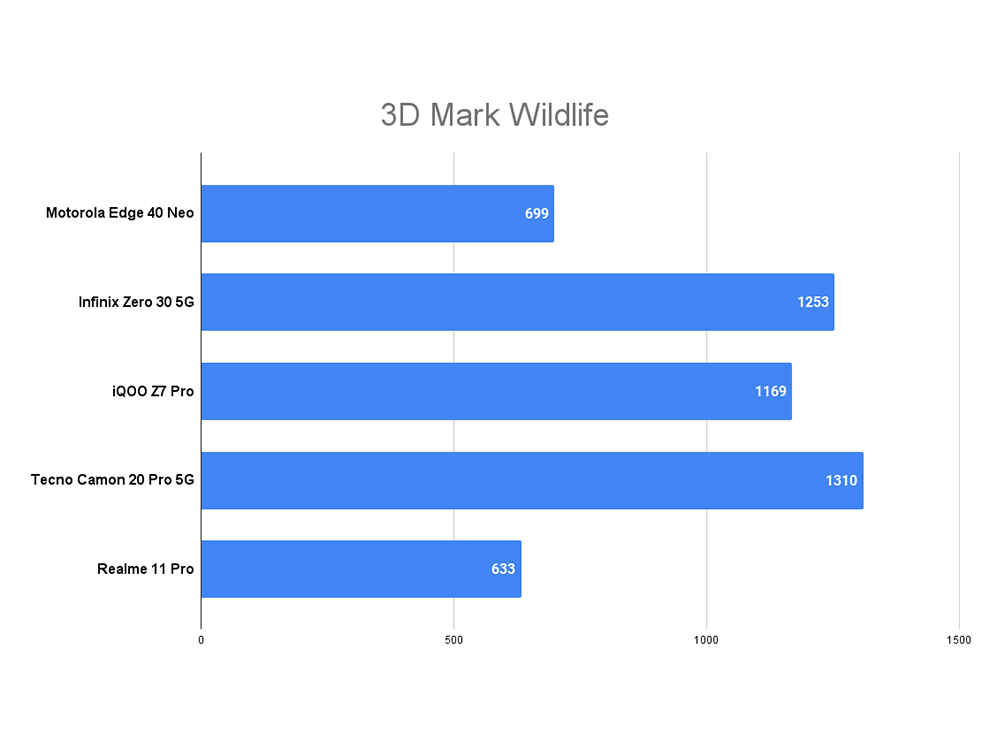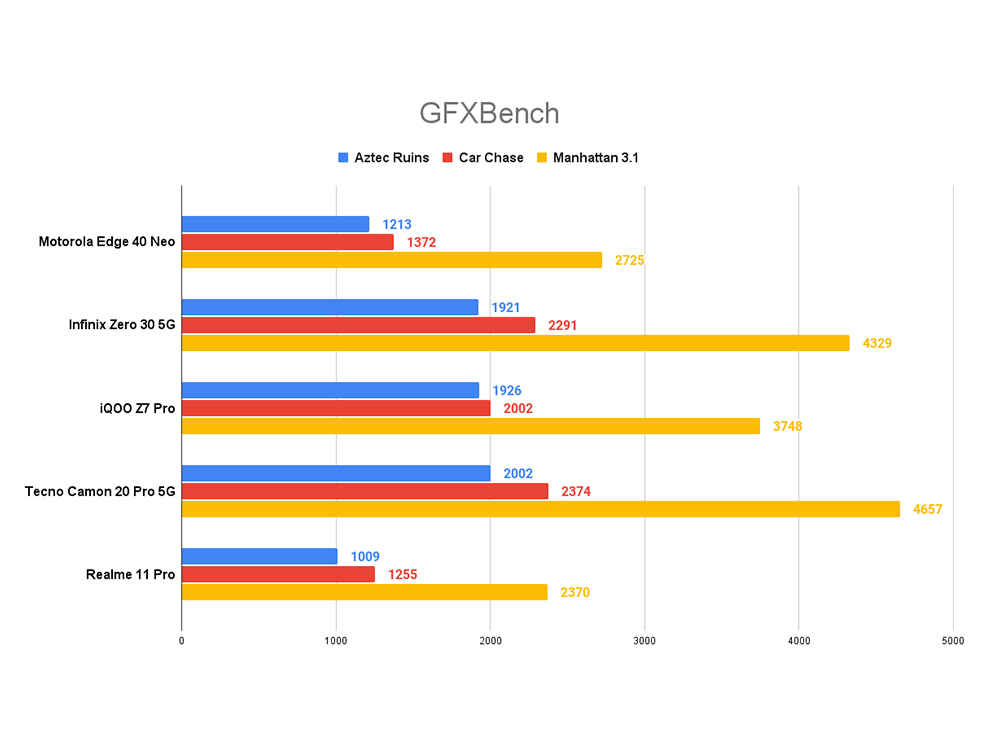So, the question is – does the Motorola Edge 40 Neo recreate the magic of the Moto Edge 40 in the sub-₹25,000 price segment? The answer to that is quite a resounding yes. It shines in the same areas the Moto Edge 40 did and it manages to do that on a tighter budget. The phone has one of the cleanest UIs on the market, a stylish and premium design, a bright and fluid display, and fast charging. What it lacks is the performance chops that some of the latest sub ₹25K phones serve up in spades.
It’s been three months since Motorola launched the Motorola Edge 40 (review) in India, but it still holds its place as one of the best mid-range smartphones in the market. While the Edge 40 is a fantastic option under ₹30K, Motorola doesn’t have too many standout offerings in the sub-₹25K price segment. To address this gap in its portfolio, the company has brought out a stripped-down version of the Moto Edge 40 dubbed the Motorola Edge 40 Neo. It takes the essence of what made the Moto Edge 40 a success and tries to emulate that in the lower mid-range space. Priced at ₹23,999, the Moto Edge 40 Neo features a premium vegan leather design (much like the Edge 40), a 144 Hz pOLED 10-bit panel, a 50 MP OIS-enabled primary camera, a large 5,000 mAh battery, and much more. However, faced with competition from the likes of the iQOO Z7 Pro (review), Infinix Zero 30 5G (review), and Realme 11 Pro (review), is this one worth your hard-earned money? Has it recreated the magic the Edge 40 had? Let’s find out.
Motorola Edge 40 Neo Review: Build and DesignThe Motorola Edge 40 Neo has almost every design characteristic of its more expensive sibling. The phone is slim at just 7.9 mm and is lightweight at merely 170 g. Once again, Motorola has collaborated with Pantone for the colours which include Caneel Bay, Soothing Sea, and Black Beauty. I got the Pantone Caneel Bay variant for review and this one, alongside the Soothing Sea variant, comes with a beautiful vegan leather rear panel. The Black variant, on the other hand, has a matte black PMMA rear panel.

The Motorola Edge 40 Neo is merely 1 g lighter than the Edge 40. Motorola claims that the Edge 40 Neo now dethrones the Edge 40 to become the world’s lightest 5G smartphone with IP68 protection. The phone is dust-sealed and water-resistant up to 1.5 metres for 30 minutes, and it is one of the ONLY smartphones at this price to offer an IP68 rating, which is fantastic.

You cannot deny how premium and svelte the Motorola Edge 40 Neo looks – it punches way above its price range with its comfortable curved edges on the front and back and the vibrant and unusual colours. There are other slim and lightweight phones with leather backs at this price though including the slimmer iQOO Z7 Pro and the new Infinix Zero 30 5G. However, neither comes packing an IP rating, let alone an IP68 rating, which is usually found in premium phones.

The Motorola Edge 40 Neo strips down some build elements to cut costs compared to the Edge 40 though. For instance, the frame is now plastic. The Edge 40 had an aluminium frame, but at under ₹25K, I won’t complain. The Edge 40 Neo is also slightly thicker at 7.9 mm compared to 7.6 mm on the Edge 40. Regardless, the Moto Edge 40 Neo is one of the best-designed phones under ₹25K with the bonus of IP68 dust and water resistance. Also, you get stereo dual speakers with Dolby Atmos support that sound wonderful. The sound is loud, punchy and clear, so props to Moto here.
Motorola Edge 40 Neo Review: DisplayDespite being cheaper, the Motorola Edge 40 Neo surprisingly has some display improvements compared to the Edge 40! You’ve got a similar 6.55-inch FHD+ pOLED panel with 144 Hz refresh rate and HDR10+ support. But on the Moto Edge 40 Neo, you’ve also got support for 1 billion colours and higher peak brightness, which is fantastic. Now, the problem I had with the Moto Edge 40 has unfortunately not been solved – Adaptive Refresh Rate mode still only goes up to 120 Hz, so to see 144 Hz in action, you would have to keep it active all the time. This would obviously deplete your battery life. Disappointing.

That aside, this sleek curved screen looks fantastic with great colours, deep blacks, and fantastic viewing angles. There were surprisingly few accidental touches on the edge of the screen – it actually does a pretty decent job at rejecting accidental corner touches. HDR content looks great on YouTube, but sadly, it is not supported on Netflix so far.

The display is also really bright; as I mentioned, brighter than the more expensive Edge 40. In our tests, I recorded 1280 nits of brightness using a LUX meter on Auto Mode under sunlight, which is brilliant for this price range. So, screen visibility is solid in any condition. Overall, this is a gorgeous curved display with impressive specifications and real-world performance.
Motorola Edge 40 Neo Review: PerformanceThe Motorola Edge 40 Neo is the world’s first phone to feature the MediaTek Dimensity 7030 SoC. It is actually not anything new though since it is the rebadged version of the Dimensity 1050. The Moto Edge 40 Neo also sports 8/12 GB of LPDDR4X RAM and 128/256 GB of UFS 2.2 storage. And, there’s no expandable storage option.

Starting off with synthetic benchmarks, I compared the Moto Edge 40 Neo to similarly-priced phones such as the iQOO Z7 Pro, Infinix Zero 30, Tecno Camon 20 Pro, and Realme 11 Pro. Sadly, it came out at the bottom in AnTuTu with a score of 5,22,651. In comparison, the iQOO Z7 Pro blew past it with a score of 7,13,216. I also put it through GeekBench, and the Moto Edge 40 Neo was once again around the bottom of the barrel, especially when it comes to Multi-Core performance.


In PCMark Work though, I got a solid score of 14,512, which means the phone will excel at completing productivity tasks with ease. The phone also shows very low throttling. I ran the CPU Throttling Test for 15 minutes with 20 threads and the phone only throttled to 94 per cent of its peak performance, which is excellent. The phone does heat slightly with heavy workloads, but it does throttle its performance, so it should be smooth most of the time.

I also tested the storage speeds via Androbench and the Moto Edge 40 Neo was outperformed by almost every other phone I tested it against in the same price range. I got only 1003 MB/s Sequential Read Speed and 919 MB/s Sequential Write Speed, which is considerably lower than the Infinix Zero 30, Tecno Camon 20 Pro, and Realme 11 Pro.
To test the GPU, I ran a couple of benchmark tests to gauge the performance. Again, I was disappointed here. In 3D Mark Wild Life Extreme, where most of its competitors scored above 1,000 points, the Moto Edge 40 Neo only clocked in 699 points. In GFXBench, the phone scored almost as low as the Realme 11 Pro while the other competitors blew past it.


The same thing was reflected in real-world gaming as well. In Call of Duty: Mobile, I booted the game at High graphics but I was still facing some frame drops. The performance is not very smooth. It was only when I turned down the graphics to Low or Medium when the performance improved. Overall, this is not the best phone under ₹25,000 for power users and gamers. Multitasking and basic day-to-day tasks work well, but I wouldn’t call it a particularly powerful device.
As for the software, you’ve got Android 13 with Moto’s MyUX skin on top. As we’ve seen before, this skin is pretty light on bloatware. The only app I could deem as bloatware was Facebook – but most users would install this anyway. There are also a few Google and Moto apps in the mix, but no games, or other third-party applications, which is amazing. You’ve also got perks such as Ready For, Family Spaces, and Moto Secure as well. The company is providing guaranteed upgrades to Android 14 and Android 15 as well as three years of security updates – which is decent, but not the best.
Motorola Edge 40 Neo Review: CameraOn paper, the Motorola Edge 40 Neo has a camera setup that’s very similar to the Moto Edge 40. You’ve got a 50 MP primary camera with Optical Image Stabilisation, a 13 MP ultrawide shooter that also works as a macro and depth lens, and a 32 MP selfie camera. However, the aperture of the primary camera is f/1.8, which is narrower than the f/1.4 aperture on the Moto Edge 40.

So, naturally, the camera isn’t able to let in as much light as the 50 MP shooter on the Moto Edge 40 and this is apparent when you click pictures in low light. The low-light pictures aren’t as detailed and noise-free as the Moto Edge 40. Additionally, the Night Mode pictures take quite a long time to shoot and unless your hands are completely still, you’re almost always going to end up with a shaky or blurry shot. So low light performance could use some work.

Pictures from the primary camera look amazing in daylight though. I clicked some sharp, detailed-looking shots when there was adequate lighting, however, the dynamic range – while decent – is not perfect. There are instances where the highlights are overblown, but honestly, I’m nitpicking here given the Edge 40 Neo’s affordable price tag.


Portraits also look amazing with almost flawless edge detection. Skin tones look pretty natural as well, and the detail retention is good for the price.

Ultrawide photos from the 13 MP camera are not bad; the colours are consistent, but the shadows do lack some detail. You can also click macro pictures through this camera and they look pretty impressive! As for selfies, the phone does well here. The skin tone depiction could be better, but at least the detail and dynamic range are pretty sound.
Motorola Edge 40 Neo Review: Battery lifeThe Motorola Edge 40 Neo has a bigger battery than its pricier sibling. It features a 5,000 mAh cell with support for 68 W fast charging. No wireless charging here though. The battery life is average for the price. I tested the battery with the phone’s refresh rate set on Auto Mode, so naturally, if you opt for 144 Hz, your mileage will differ – probably drastically.

In our 4K video loop test, which we do on every phone we review, the Motorola Edge 40 lasted 14 hours and 35 minutes until the battery died out. This is consistent enough with the battery performance of other competitors such as the Infinix Zero 30, iQOO Z7 Pro, and Realme 11 Pro. So, the battery life is nothing extraordinary but it doesn’t fall short either.
Most users should comfortably get through a day’s worth of usage, and if you’re a light user, you may even squeeze out a day and a half worth of battery. The 68 W charging is quite speedy – the phone charges up to full in just under an hour, which is pretty decent. Also, the charger is provided in the box, which is something I’m having to mention more than I’d like to these days.
Motorola Edge 40 Neo Review: VerdictSo, the question is – does the Motorola Edge 40 Neo recreate the magic of the Moto Edge 40 in the sub-₹25,000 price segment? The answer to that is quite a resounding yes. It shines in the same areas the Moto Edge 40 did and it manages to do that on a tighter budget. The phone has one of the cleanest UIs on the market, a stylish and premium design, a bright and fluid display, and fast charging. What it lacks is the performance chops that some of the latest sub ₹25K phones serve up in spades. You won’t have the smoothest gaming experience but if you can live with that, the Motorola Edge 40 Neo is a winner. The ₹23,999 price point is a pretty sweet spot but as part of an introductory discount offer, you can even grab the phone for as low as ₹20,999.
from Mobile Phones Reviews https://ift.tt/rg5NXwq
Comments
Post a Comment